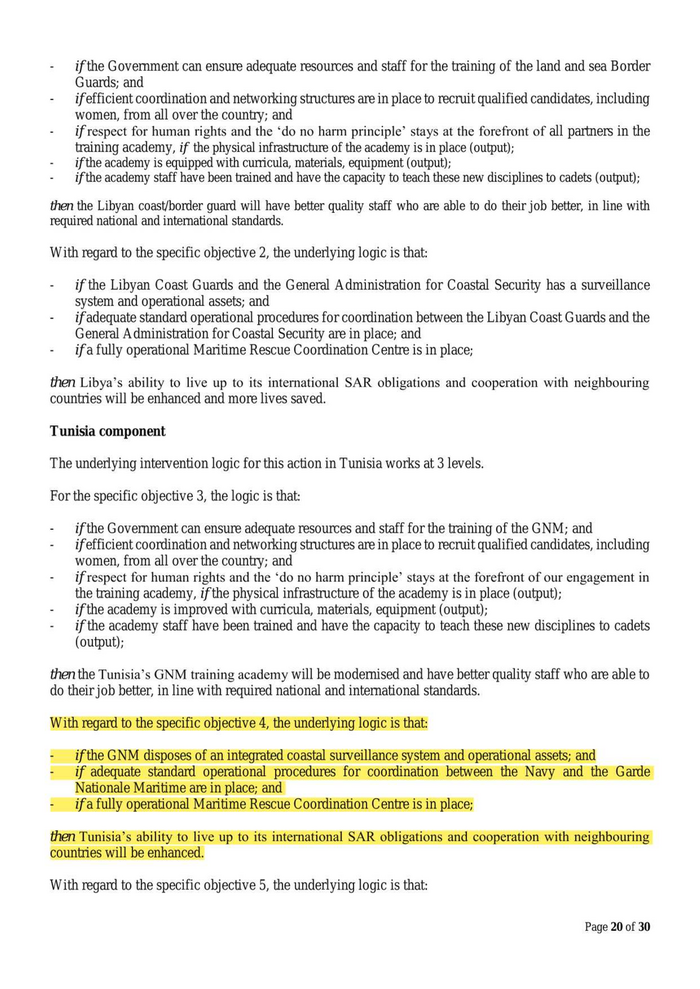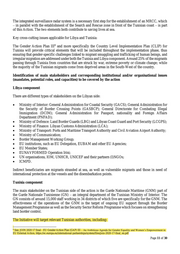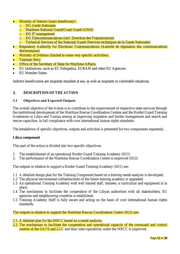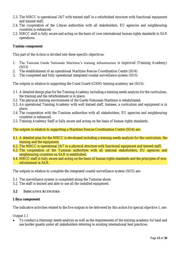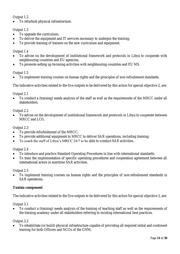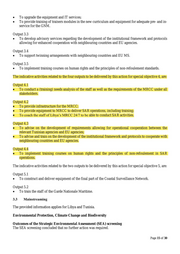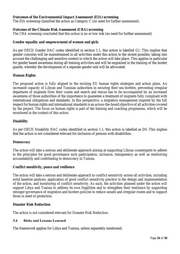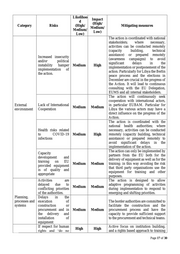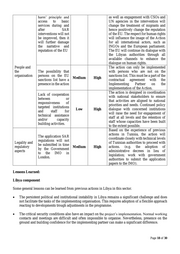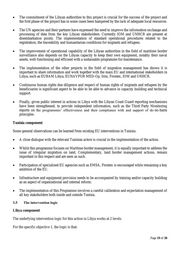EU_Support_Border_Management_Libya_Tunisia
The integrated surveillance radar system is a necessary first step for the establishment of an MRCC, which — in parallel with the establishment of the Search and Rescue zone in front of the Tunisian coast — is part of this Action. The two elements both contribute to saving lives at sea. Key cross-cutting issues applicable for Libya and Tunisia: The Gender Action Plan III® and more specifically the Country Level Implementation Plan (CLIP) for Tunisia will provide critical elements that will be included throughout the implementation phase, thus ensuring that gender-specific challenges linked to migrant smuggling and trafficking of human beings, and irregular migration are addressed under both the Tunisia and Libya component. Around 25% of the migrants passing through Tunisia from countries that are struck by war, extreme poverty or climate change; while the majority of the Tunisian migrants come from deprived areas in the South-W est of the country. Identification of main stakeholders and corresponding institutional and/or organisational issues (mandates, potential roles, and capacities) to be covered by the action Libya component There are different types of stakeholders on the Libyan side: e Ministry of Interior: General Administration for Coastal Security (GACS); General Administration for the Security of Border Crossing Points (GASBCP); General Directorate for Combating Illegal Immigration (DCIM); General Administration for Passport, nationality and Foreign Affairs Department (PNFAD); Ministry of Defence: Land Border Guards (LBG) and Libyan Coast Guard and Port Security (LCGPS); Ministry of Finance: Libyan Customs A dministration (LCA); Ministry of Transport: Ports and Maritime Transport Authority and Civil Aviation Airport Authority; Ministry of Communication; Border Management Working Group; EU institutions, such as EU Delegation, EUBAM and other EU A gencies; EU Member States; EUNAVFORMED Operation Irini; UN organisations, IOM, UNHCR, UNICEF and their partners (D)NGOs; ICMPD. Indirect beneficiaries are migrants stranded at sea, as well as vulnerable migrants and those in need of international protection at the vessels and the disembarkation points. Tunisia component The main stakeholder on the Tunisian side of the action is the Garde Nationale Maritime (GNM) part of the Garde Nationale Tunisienne (GN) — an integral department of the Tunisian Ministry of Interior. The GN consists of around 15,000 staff working in 34 districts of which five are specifically forthe GNM. The effectiveness of the operations of the GNM is the target of ongoing EU support through the Border Management Programme as well as the Security Sector Reform Programme which focuses on strengthening land border control. Page 11 of 30
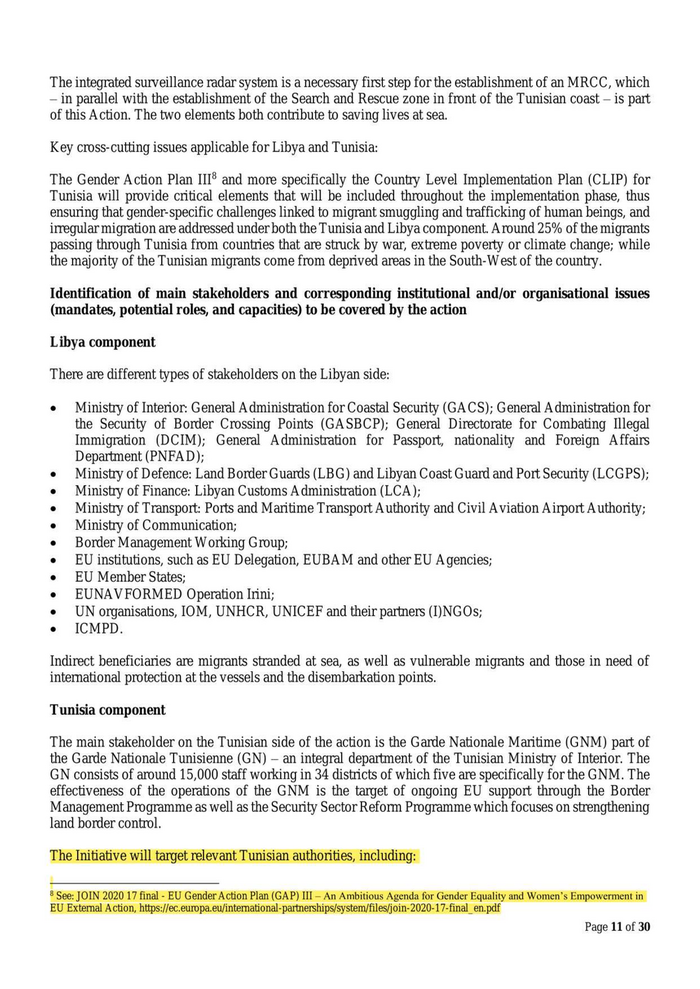
° EU institutions, such as EU Delegation, EUBAM and other EU Agencies e EU Member States Indirect beneficiaries are migrants stranded at sea, as well as migrants in vulnerable situations. 3. DESCRIPTIONOFTHE ACTION 3.1 Objectives and Expected Outputs The overall objective of the Action is to contribute to the improvement of respective state services through the institutional development of the Maritime Rescue Coordination Centres and the Border Guard Training Academies in Libya and Tunisia aiming at improving migration and border management and search and rescue capacities, in full compliance with core international human rights standards. The breakdown of specific objectives, outputs and activities is presented for two components separately. Libya component This part of the action is divided into two specific objectives: 1. The establishment of an operational Border Guard Training Academy (SO1) 2. The performance of the Maritime Rescue Coordination Centre is improved (SO2) The outputs in relation to support a Border Guard Training Academy (SO1) are: 1.1 A detailed design plan for the Training Component based on a training needs analysis is developed; 1.2 The physical environment (infrastructure) of the future training academy is upgraded; 1.3 An operational Training Academy with well trained staff, trainees, a curriculum and equipment is in place; 1.4 The mechanism to facilitate the cooperation of the Libyan authorities with all stakeholders, EU agencies and neighbouring countries is established; 1.5 Training Academy Staff is fully aware and acting on the basis of core international human rights standards. - centres oftheGACS and LCG and their inter-operability under the MRCC is improved;
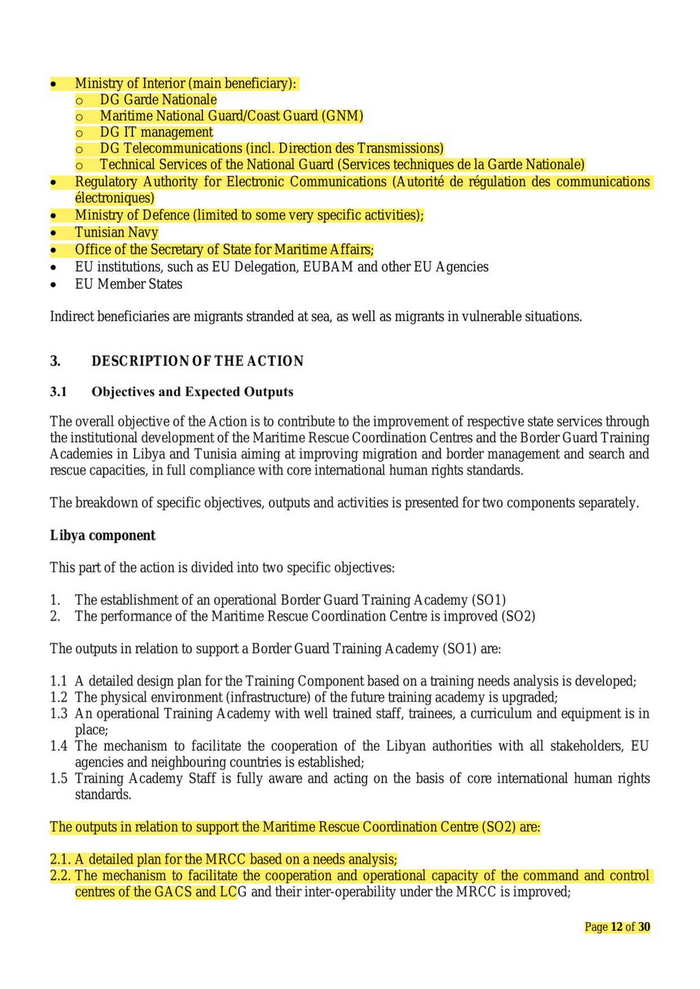
2.3. The MRCC is operational 24/7 with trained staff in a refurbished structure with functional equipment and trained staff; 2.4. The cooperation of the Libyan authorities with all stakeholders, EU agencies and neighbouring countries is enhanced; 2.5. MRCC staff is fully aware and acting on the basis of core international human rights standards in SAR operations. Tunisia component This part of the Action is divided into three specific objectives: 1. The Tunisian Garde Nationale Maritime’s training infrastructure is improved (Training Academy) (SO3) 2. The establishment of an operational Maritime Rescue Coordination Centre (SO4) 3. The completed and fully operational integrated coastal surveillance system (SO5) The outputs in relation to supporting the Coast Guard (GNM) training academy are (SO3): 3.1. A detailed design plan forthe Training Academy including a training needs analysis forthe curriculum, the training and the refurbishment is in place; 3.2. The physical training environment of the Garde Nationale Maritime is rehabilitated; 3.3. An operational Training Academy with well trained staff, trainees, a curriculum and equipment is in place; 3.4. The cooperation with the Tunisian authorities with all stakeholders, EU agencies and neighbouring countries is enhanced; 3.5. Training Academy Staff is fully aware and acting on the basis of human rights standards. The outputs in relation to complete the integrated coastal surveillance system (SO5) are: 5.1. The surveillance system is completed along the Tunisian shore; 5.2. The staff is trained and able to use all the installed equipment. 3.2 INDICATIVE ACTIVITIES Libya component The indicative activities related to the five outputs to be delivered by this action for special objective 1, are: Output 1.1 «e Toconducta (training) needs analysis as well as the requirements of the training academy for land and sea border quards under all stakeholders referring to existing international best practices. Page 13 of 30
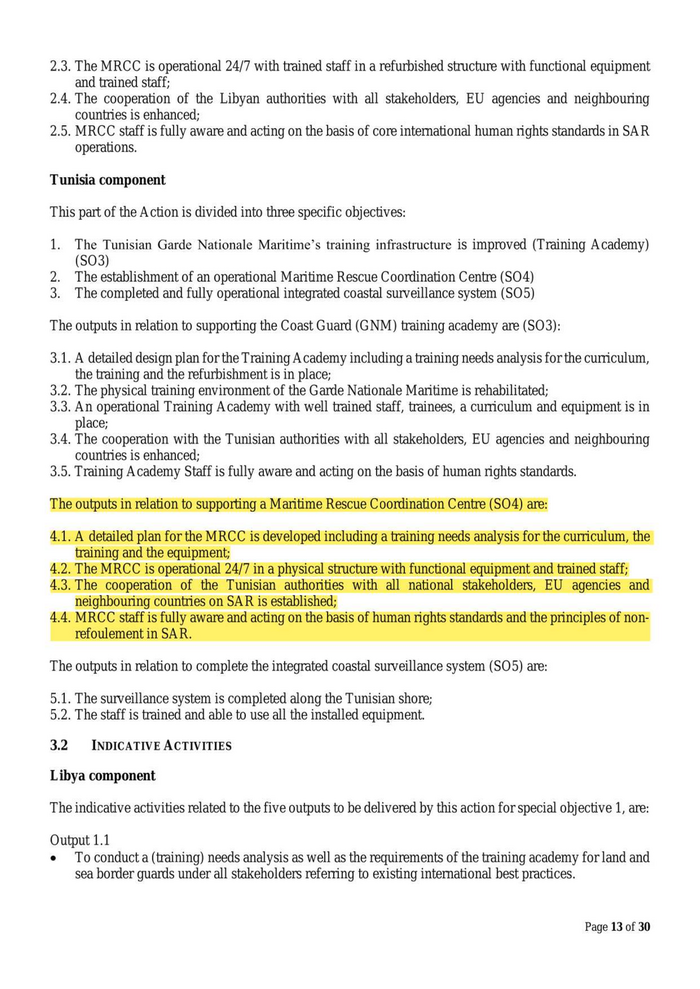
Output 1.2 «e To refurbish physical infrastructure. Output 1.3 e To upgrade the curriculum; « To deliverthe equipment and IT services necessary to underpin the training; «e To provide training of trainers on the new curriculum and equipment. Output 1.4 e To advise on the development of institutional framework and protocols in Libya to cooperate with neighbouring countries and EU agencies; «e To promote setting up twinning activities with neighbouring countries and EU MS. Output 1.5 «e To implement training courses on human rights and the principles of non-refoulement standards. The indicative activities related to the five outputs to be delivered by this action for special objective 2, are: Output 2.1 e To conducta (training) needs analysis of the staff as well as the requirements of the MRCC under all stakeholders. Output 2.2 e To.advise on the development of institutional framework and protocols in Libya to cooperate between MRCC and LCG. Output 2.3 «e To provide refurbishment of the MRCC; «e To provide additional equipment to MRCC to deliver SAR operations, including training; e To coach the staff of Libya’s MRCC 24/7 to be able to conduct SAR activities. Output 2.4 e To introduce and practice Standard Operating Procedures in line with international standards; «e To train the implementation of specific operating procedures and cooperation agreement between all international actors in maritime SAR activities. Output 2.5 «e To implement training courses on human rights and the principles of non-refoulement standards in SAR operations. Tunisia component The indicative activities related to the five outputs to be delivered by this action for special objective 3, are: Output 3.1 «e To conduct a (training) needs analysis of the training of teaching staff as well as the requirements of the training academy under all stakeholders referring to existing international best practices. Output 3.2 e To rehabilitate (or build) physical infrastructure capable of providing all required initial and continued training for both Officers and NCOs of the GNM; Page 14 of 30
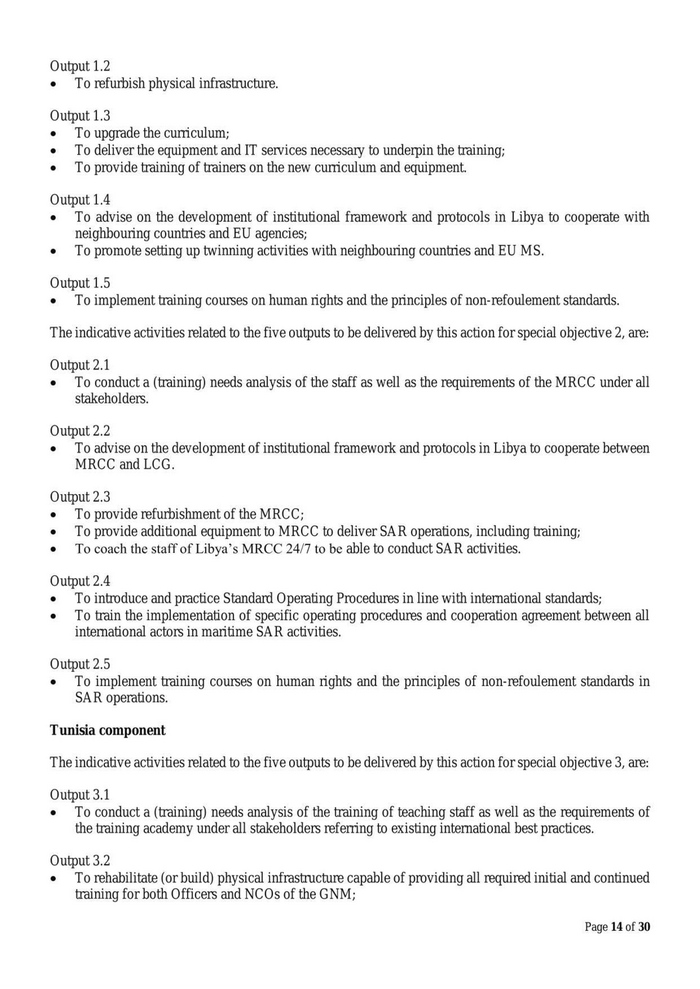
«e To upgrade the equipment and IT services; «e To provide training of trainers modules in the new curriculum and equipment for adequate pre- and in- service forthe GNM. Output 3.3 «e To develop advisory services regarding the development of the institutional framework and protocols allowing for enhanced cooperation with neighbouring countries and EU agencies. Output 3.4 «e To support twinning arrangements with neighbouring countries and EU MS. Output 3.5 «e To implement training courses on human rights and the principles of non-refoulement standards. T 7 The indicative activities related to the two outputs to be delivered by this action for special objective 5, are: Output 5.1 «e To construct and deliver equipment of the final part of the Coastal Surveillance Network. Output 5.2 « To train the staff of the Garde Nationale Maritime. 3.3 Mainstreaming The provided information applies for Libya and Tunisia. Environmental Protection, Climate Change and Biodiversity Outcomes of the Strategic Environmental Assessment (SEA) screening The SEA screening concluded that no further action was required. Page 15 of 30
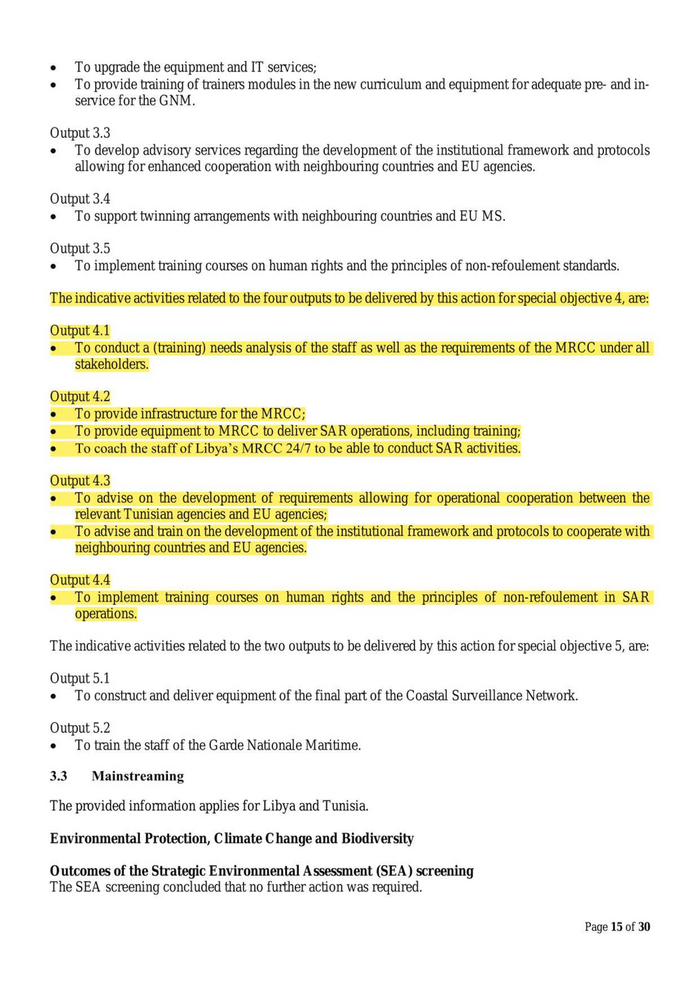
Outcomes of the Environmental Impact Assessment (EIA) screening The EIA screening classified the action as Category C (no need for further assessment). Outcome of the Climate Risk Assessment (CRA) screening The CRA screening concluded that this action is no or low risk (no need for further assessment) Gender equality and empowerment of women and girls As per OECD Gender DAC codes identified in section 1.1, this action is labelled G1. This implies that gender concerns will be mainstreamed in all activities under this action to the extent possible, taking into account the challenging and sensitive context in which the action will take place. This applies in particular for gender based awareness during all training activities and will be engrained in the training of the border guards, whereby the development of a separate gender unit will be advocated. Human Rights The proposed action is fully aligned to the existing EU human rights strategies and action plans. An increased capacity of Libyan and Tunisian authorities in securing their sea borders, preventing irregular departures of migrants from their coasts and search and rescue has to be accompanied by an increased awareness of those authorities of the importance to guarantee a treatment of migrants fully compliant with international obligations and standards. In this perspective, a migration management inspired by the full respect for human rights and international standards is an across-the-board objective of all activities covered by the project. The focus on human rights is part of the training and coaching programme, which will be monitored in the context of this action. Disability As per OECD Disability DAC codes identified in section 1.1, this action is labelled as DO. This implies that the action is not considered relevant for inclusion of persons with disabilities. Democracy The action will take a serious and deliberate approach aiming at supporting Libyan counterparts to adhere to the principles for good governance such participation, inclusion, transparency as well as reinforcing accountability and contributing to democracy in Tunisia. Conflict sensitivity, peace and resilience The action will take a serious and deliberate approach to conflict sensitivity across all activities, including solid baseline analysis, application of good conflict sensitivity practice in the design and implementation of the action, and monitoring of conflict sensitivity. As such, the activities planned under the action will support Libya and Tunisia to address its own fragilities and to strengthen their resilience by supporting stronger governance of migration and borders policies to reduce unsafe and irregular routes and to support those in need of protection. Disaster Risk Reduction The action is not considered relevant for Disaster Risk Reduction. 3.4 Risks and Lessons Learned The framework applies for Libya and Tunisia, unless separately mentioned. Page 16 of 30
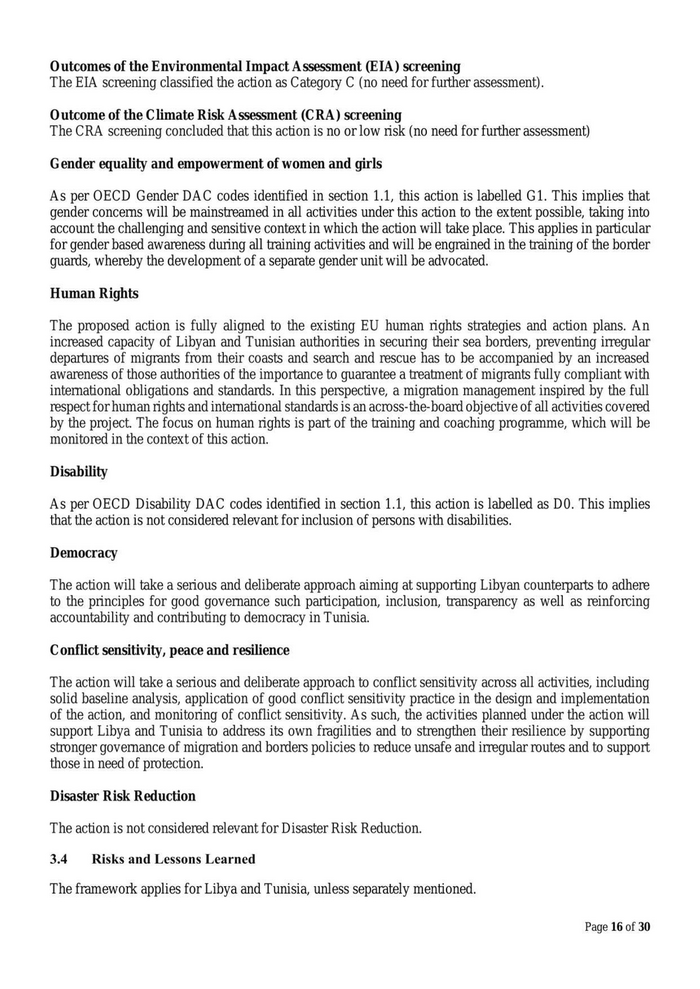
Increased insecurity and/or political instabilitiy hamper implementation of the action. External Lack of International environment | Cooperation Health risks related to COVID-19 infections Capacity development and training on EU provided equipment is of quality and appropriate Activities are delayed due to conflicting priorities of the authorities. Planning, Delays in the processes and | execution of systems construction or procurement and in the delivery and installation of equipment If respect for human riehts and ‘do no Mitigating measures The action is coordinated with national stakeholders; where necessary, activities can be conducted remotely (capacity building, technical assistancee) or prepared remotely (awareness campaigns) to avoid significant delays in the implementation or postponement of the action. Particularly for Libya the Berlin peace process and the elections in December are crucial in the progress of the Action. It will lead to continuous consulting with the EU Delegation, EUMS and all internal stakeholders. The action will continuously seek cooperation with international actors, in particular EUBAM. Particular for Libya the various actors may have a direct influence on the progress of the Action. The action is coordinated with the national health authorities; where necessary, activities can be conducted remotely (capacity building, technical assistance) or prepared remotely to avoid significant delays in the implementation of the action. The action can only be implemented by partners from the EU both for the delivery of equipment as well as forthe training; in this way avoiding the risk that third party organisations use the equipment for training and other purposes. The action is designed to allow adaptive programming of activities during implementation to respond to ing and shifting priorities. The border authorities are committed to facilitate the construction and the procurement process and have the capacity to provide sufficient support to the procurement and technical teams. Active focus on institution building, and a rights based approach to training Page 17 of 30
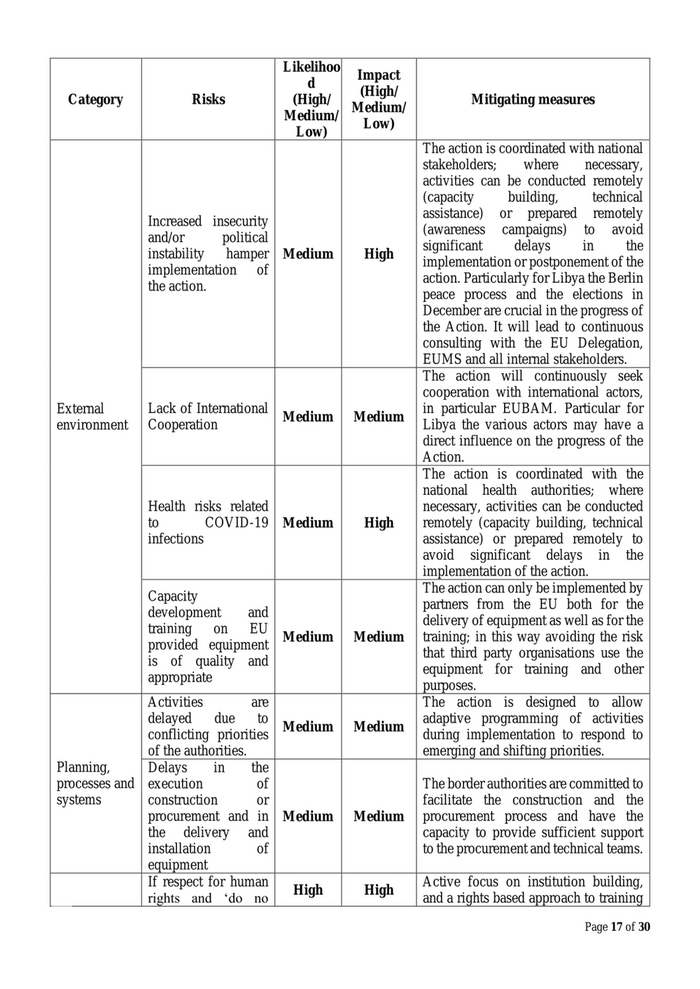
People and the organisation Legality and regulatory aspects harm’ principle and access to basic services during and after SAR interventions will not be improved, then it will further damage the narrative and reputation of the EU The possibility that persons on the EU sanctions list have a presencein the action Lack of cooperation between or responsiveness of targeted institutions and staff for technical assistance and/or capacity building activities. The application SAR regulations will not be submitted in time by the Government to the IMO in London. Lessons Learned: Libya component as well as engagement with CSOs and UN agencies in the intervention will change the treatment of migrants and hence positively change the reputation ofthe EU. The respect for human rights will influence the image of the Action for all intemational actors, such as INGOs and the European parliament. The EU will continue its dialogue with the Libyan authorities through all available channels to enhance the dialogue on human rights. The action can only be implemented with persons who are not on the sanctions list. This must be a part of the contractual agreement with the Implementing Partner on the implementation of the Action. The action is designed in coordination with national stakeholders to ensure that activities are aligned to national priorities and needs. Continued policy dialogue with concerned institutions will raise the need for engagement of staff at all levels and the retention of staff whose capacities have been built to the extent possible. Based on the experience of previous actions in Tunisia, the action will coordinate closely with technical levels of Tunisian authorities to proceed with actions. (eg. the adoption of administrative decrees in lieu of legislation, work with government authorities to submit the application papers to the IMO). Some general lessons can be learned from previous actions in Libya in this sector. The persistent political and institutional instability in Libya remains a significant challenge and does not facilitate the tasks of the implementing organisation. This requires adoption of a flexible approach reacting to developments trough adjustments in the programme. The critical security conditions also have an impact on the projects implementation. Normal working contacts and meetings are difficult and often impossible to organise. Nevertheless, presence on the ground and building confidence for the implementing partner can make a significant difference. Page 18 of 30
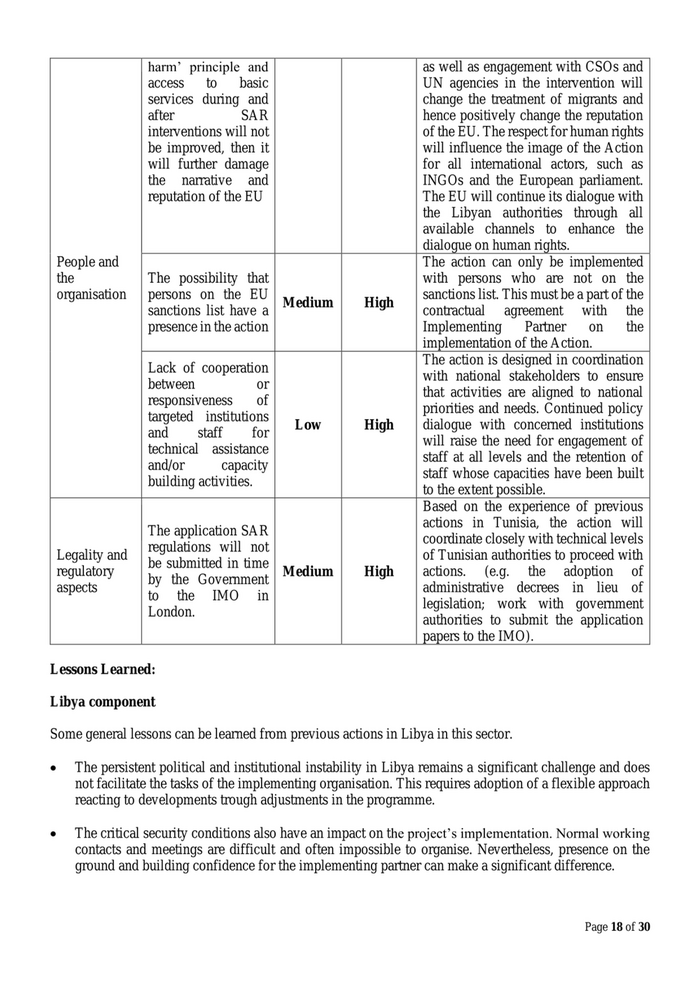
The commitment of the Libyan authorities to this project is crucial for the success of the project and the first phase of the project has in some cases been hampered by the lack of adequate local resources. The UN agencies and their partners have expressed the need to improve the information exchange and processing of data from the key Libyan stakeholders. Currently IOM and UNHCR are present at disembarkation points. The implementation of standard operational procedures related to the registration, the traceability and humanitarian conditions for migrants and refugees. The improvement of operational capability of the Libyan authorities in the field of maritime border surveillance also depends on the Libyan capacity to keep their own equipment, notably their naval assets, well-functioning and efficient with a sustainable programme for maintenance. The implementation of the other projects in the field of migration management has shown it is important to share information and work together with the main EU and international stakeholders in Libya, such as EUBAM Libya, EUNAVFOR MED-Op. Irini, Frontex, IOM and UNHCR. Continuous human rights due diligence and respect of human rights of migrants and refugees by the beneficiaries is significant aspect to be able to be able to advance in capacity building and technical support. Finally, given public interest in actions in Libya with the Libyan Coast Guard reporting mechanisms have been strengthened, to provide independent information, such as the Third Party Monitoring reports on the programmes’ effectiveness and their compliance with and support of do-no-harm principles. Tunisia component Some general observations can be leamed from existing EU interventions in Tunisia: 3.5 A close dialogue with the relevant Tunisian actors is crucial in the implementation of the action. Whilst this programme focuses on Maritime border management, it is equally important to address the issue of irregular migration on land. Complementary, land border management actions, remain important in this respect and are seen as such. Participation of specialised EU agencies such as EMSA, Frontex is encouraged while remaining a key ambition of the EU. Infrastructure and equipment provision needs to be accompanied by training and/or capacity building as an aspect of organisational and internal reform. The implementation of this Programme involves a careful calibration and expectation management of all key stakeholders both inside and outside Tunisia. The intervention logie Libya component The underlying intervention logic for this action in Libya works at 2 levels. For the specific objective 1, the logic is that: Page 19 of 30
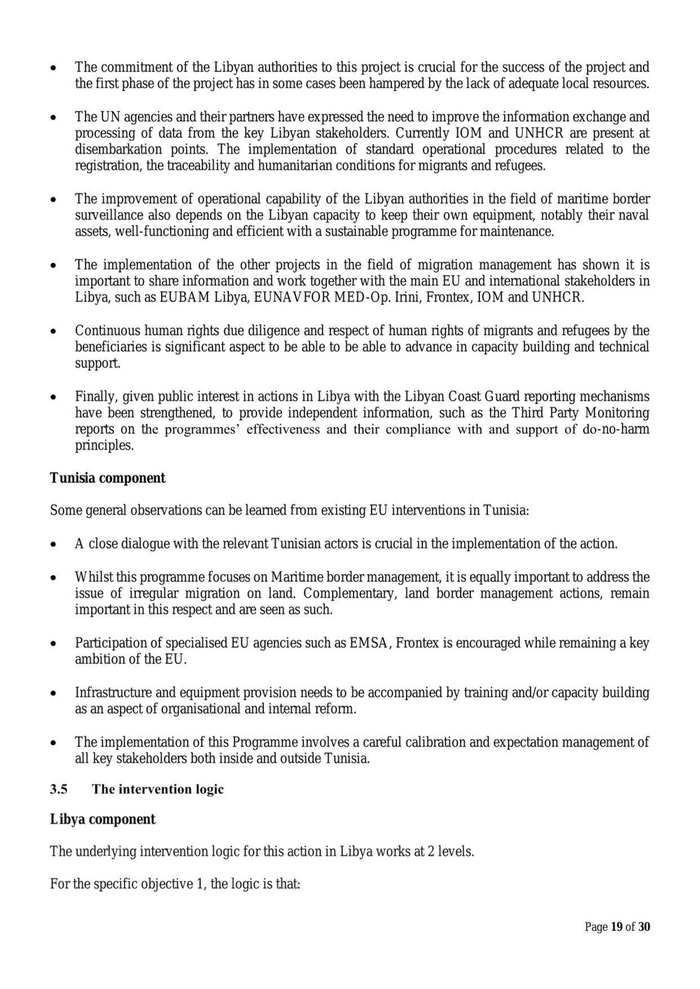
ifthe Government can ensure adequate resources and staff for the training of the land and sea Border Guards; and ifefficient coordination and networking structures are in place to recruit qualified candidates, including women, from all overthe country; and ifrespect for human rights and the ‘do no harm principle’ stays at the forefront of all partners in the training academy, if the physical infrastructure of the academy is in place (output); ifthe academy is equipped with curricula, materials, equipment (output); ifthe academy staff have been trained and have the capacity to teach these new disciplines to cadets (output); then the Libyan coast/border guard will have better quality staff who are able to do their job better, in line with required national and international standards. With regard to the specific objective 2, the underlying logic is that: ifthe Libyan Coast Guards and the General Administration for Coastal Security has a surveillance system and operational assets; and ifadequate standard operational procedures for coordination between the Libyan Coast Guards and the General Administration for Coastal Security are in place; and ifa fully operational Maritime Rescue Coordination Centre is in place; then Libya’s ability to live up to its international SAR obligations and cooperation with neighbouring countries will be enhanced and more lives saved. Tunisia component The underlying intervention logic for this action in Tunisia works at 3 levels. For the specific objective 3, the logic is that: ifthe Government can ensure adequate resources and staff for the training of the GNM; and ifefficient coordination and networking structures are in place to recruit qualified candidates, including women, from all over the country; and ifrespect for human rights and the ‘do no harm principle’ stays at the forefront of our engagement in the training academy, ifthe physical infrastructure of the academy is in place (output); ifthe academy is improved with curicula, materials, equipment (output); ifthe academy staff have been trained and have the capacity to teach these new disciplines to cadets (output); then the Tunisia’s GNM training academy will be modernised and have better quality staff who are able to do their job better, in line with required national and international standards. With regard to the specific objective 5, the underlying logic is that: Page 20 of 30
